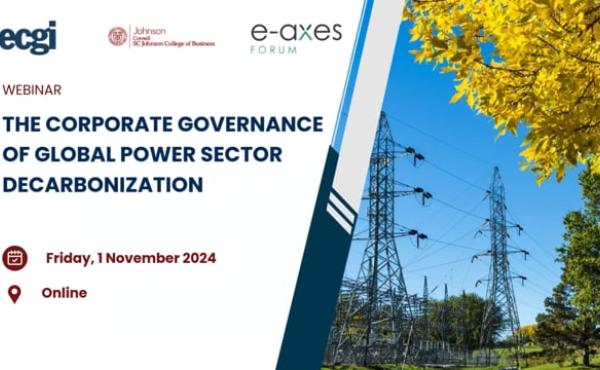
The ECGI blog is kindly supported by

Unlocking Trillions of Climate Finance at COP29
Despite the urgency in reducing greenhouse gas emissions, the global transition to net-zero has barely begun in economically advanced countries. Moreover, emissions in emerging and developing market economies (EMDEs) are growing rapidly. So that global annual emissions are at an all-time high. The remaining carbon budget, if we are to keep the increase in temperatures below 1.5-degrees above pre-industrial levels, will be exhausted within five years at the current rate of annual emissions.
Why do we care about the 1.5 degrees limit? Because any 0.1 degree increase above 1.5 degrees significantly increases the risk of crossing irreversible tipping points, plunging the planet into a hothouse climate.
Any timely transition to net zero must include “climate finance at scale” to support a green development path of emerging and developing economies. While domestic climate packages, such as the EU’s Green Deal and the US Inflation Reduction Act have incentivized renewable investments in advanced economies, capital flows into renewables in emerging and developing economies have been close to non-existent (IEA-IFC 2023). This is despite the exponential decline of investment costs in renewable technologies. As many analysts have highlighted, a critical hurdle is the prohibitively high cost of capital in EMDEs. Another hurdle is the fierce lobbying by owners of fossil fuels and communities dependent upon them against early retirement of fossil fuels.
A 2024 paper, “The economic case for climate finance at scale,” proposes one way forward: supporting climate finance at scale to EMDEs by tying renewable investments to the phase out of coal. To be sure, the benefits from avoided emissions deliver large net economic benefits to advanced economies, even if these countries pay the lion share of the fossil fuel-to-renewable transition in EMDEs.
With a share of one quarter of public funds and three quarters of private funds, the total fiscal cost of paying for all of the coal-to-renewable transition in EMDEs (excl. China) for advanced economies would be around $1.3tn from 2024 to 2030. This would be less than 0.3% of the annual GDP of a coalition including the US, EU, Canada, the UK, and Japan. It would deliver a net economic return exceeding 150%, even on the conservative assumption that the global social cost of carbon is $80 per ton of carbon dioxide.
It is not sufficient for advanced countries to reach net zero in time. The planet would still be headed for climate disaster if EMDEs are not on board. This is the fundamental reason why the economic benefits to advanced countries, in terms of lower climate damages and global instability, far exceed the costs of decarbonizing EMDEs.
We all know that climate finance is far from having reached the necessary scale. There has been too much foot dragging for far too long. An important reason is that the case for climate finance at scale has been wrongly argued. It has been exclusively framed in terms of fairness (a just energy transition), overlooking the immense economic benefits to the world, and therefore also to advanced economies, from replacing fossil fuels with renewable energy (obtained by tying renewable energy development to the phasing out of fossil fuels). Paying a polluter, EMDEs, to stop polluting is not only just, but, as we show, also in the economic interest of the West.
With less than five months to go before the COP29 Climate Summit in November, there is still no agreement in sight on how to bridge the near-one trillion-dollar gap between what EMDEs say is needed and the roughly $100bn annual climate finance currently offered by advanced countries. The Azerbaijan Presidency of the COP29 confirmed that brokering a global agreement on a new annual international climate finance goal is its "top negotiating priority" for the COP29 climate summit.
Moral obligations are not a strong enough impetus for action. As William Nordhaus notes, “Global warming is a trillion-dollar problem requiring a trillion-dollar solution, and that demands a (far more) robust incentive structure”. Climate finance at scale can provide such a structure, benefiting key stakeholders: (1) countries, (2) fossil fuel communities, and (3) investors.
Countries
Climate finance at scale for EMDEs is not charity, but hard-nosed economic self-interest. Paying the polluter to stop polluting, by offering climate finance that covers both (i) compensation for the stranded asset value of fossil fuels and their communities and (ii) finance the catalytic part of the investment costs in replacement renewables is sound economic logic, as it makes Western countries (1), as well as recipient countries, economically better off.
Fossil fuel communities
Compensating for early fossil fuel closure (which can, for instance, be operationalized via auctions) provides financial incentives for the fossil fuel industry to support the green transition, ensuring that fossil fuel owners and workers are at least as well off as they would be under business as usual. It is also an economic bargain, as economic benefits exceed the compensation cost by several magnitudes. Compensation is preferable over carbon credits to close fossil fuels early, as the latter will at best be additional (offsetting a positive emission), whereas rapid absolute emission reductions are needed to stay within the carbon budget.
Investors
Deploying government climate finance funds to attract private capital through a blended finance approach minimizes the burden on public coffers. This strategy means that investors do not need to be impact or ESG investors to finance the EMDE transition. By de-risking investments against, among others, political, foreign exchange, and return risks, public climate finance raises private risk-adjusted returns above the hurdle rate, making renewable investments in EMDEs by investors simply good business.
In today’s climate of ESG backlash, where ESG investors face scrutiny over their fiduciary duty to maximize shareholder returns, this approach is crucial. Multilateral development banks (MDBs) would collaborate with EMDE countries to prepare both the fossil fuel phase-out and renewable phase-in pipelines. This preparation would involve compensating for phase-out and de-risking phase-in investments, allowing capital market investors to invest in large-ticket size, bankable renewable projects. This collaboration is crucial to ensure that the transition to a green economy is both feasible and economically beneficial for all parties involved. As part of this collaboration, MDBs must evolve from a project-based finance model to facilitating a system-wide transition in these countries.
For company directors, this means integrating climate financing and risks into their overall risk management frameworks and strategic planning. Boards should ensure that their investments and corporate goals are aligned with sustainability objectives. Enhanced transparency and disclosure of climate-related risks and opportunities are crucial, with companies expected to report comprehensively on their climate impact and mitigation strategies. Active engagement with stakeholders, including investors, regulators, and the community, is vital to build trust and accountability on climate issues.
Investors, on the other hand, play a pivotal role in driving the transition to a green economy. They should demand public-private partnerships for influencing (or setting) the cost of capital for renewable investments in EDMEs, where costs of capital are punitive, and call on advanced countries to scale public climate finance for EMDEs (via MBDs) to make this possible via system-wide blended finance. They should also demand climate accountability, support sustainable investments, and advocate for policy changes that foster a robust framework for large-scale climate finance. By prioritizing investments in renewable energy and supporting policy advocacy, investors can help create a more sustainable and stable global economy.
“The economic case for climate finance at scale” maps a way forward grounded in basic economic logic. Tying the benefits from avoided emissions to the development costs of renewables is key. Equally important is compensating affected owners and workers for the early termination of fossil-fuel production (by compensating for the stranded asset value and temporary loss of wages and retraining cost), which should motivate them to accept the green transition. Public finance must also crowd in private capital via system-wide blended finance, which would reduce the burden on taxpayers.
As the world approaches the critical juncture of COP29, the imperative for climate finance at scale has never been clearer. It is a matter of strategic economic necessity that promises substantial returns for advanced economies while averting global climate catastrophe. Unlocking trillions in climate finance is achievable through a multi-faceted approach. Blended finance models can reduce the overall fiscal burden on taxpayers. Tying renewable investments to the phase-out of fossil fuels ensures that the transition to a green economy is economically viable. Compensation mechanisms for affected owners and workers can facilitate the acceptance of this transition. Additionally, multilateral collaboration involving development banks, capital markets, and renewable energy developers is essential to create large pools of bankable projects. By embracing this path, we can unlock trillions in climate finance, foster global stability, and secure a sustainable future for generations to come.
______________________
By Alissa M. Kleinnijenhuis (Cornell University and Imperial College London), Patrick Bolton (Imperial College London) & Jeromin Zettlemeyer (Bruegel)
Read Alissa Kleinnijenhuis's opinion piece, "Paying Polluters to Stop Polluting is Sound Economic Logic," published in the Financial Times, August 6, 2024.
The ECGI does not, consistent with its constitutional purpose, have a view or opinion. If you wish to respond to this article, you can submit a blog article or 'letter to the editor' by clicking here.
Related materials
In this joint webinar, Patrick Bolton and Alissa Kleinnijenhuis presented their insights on the corporate governance implications of the financial strategies underlying the decarbonization of the global power sector, drawing from their paper, “The Economic Case for Climate Finance at Scale,” and new research focused on the global power sector. Franklin Allen, Nuno Fernandes, and Alexander Wagner commented and partook in a panel discussion on climate finance to decarbonize the global economy, with Anastasia Pappas moderating a 25-minute Q&A session involving the panel and the online audience.







